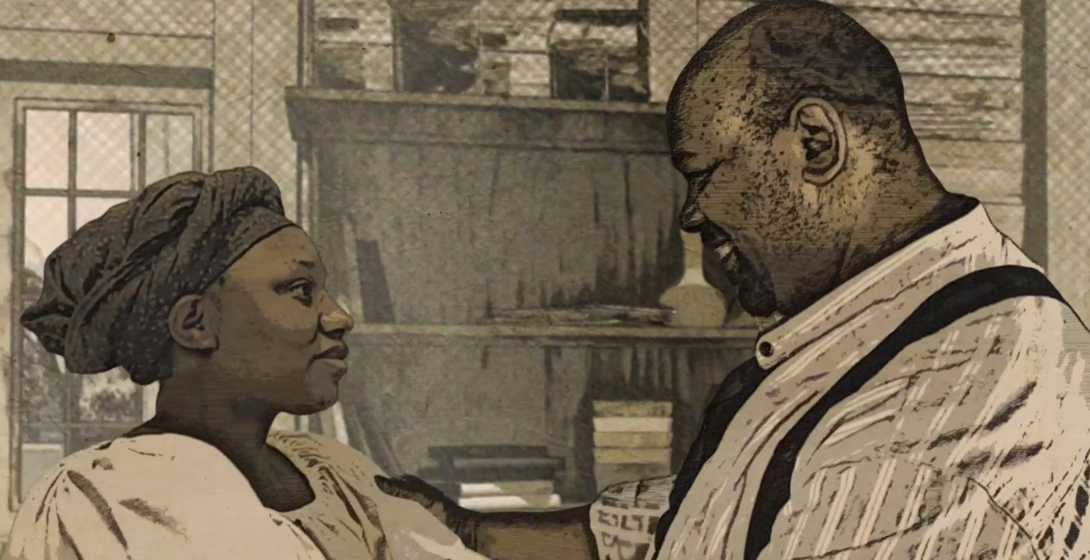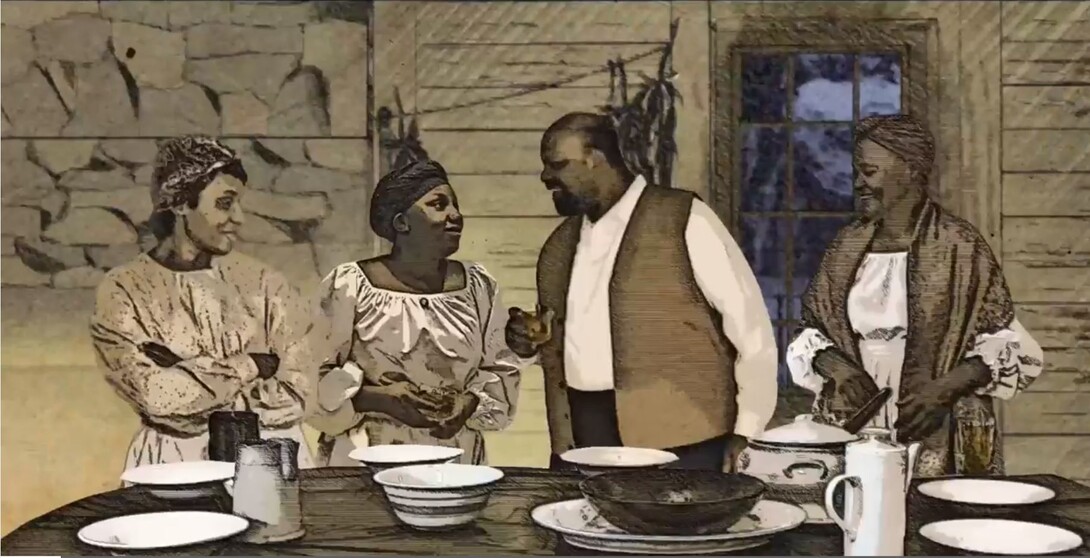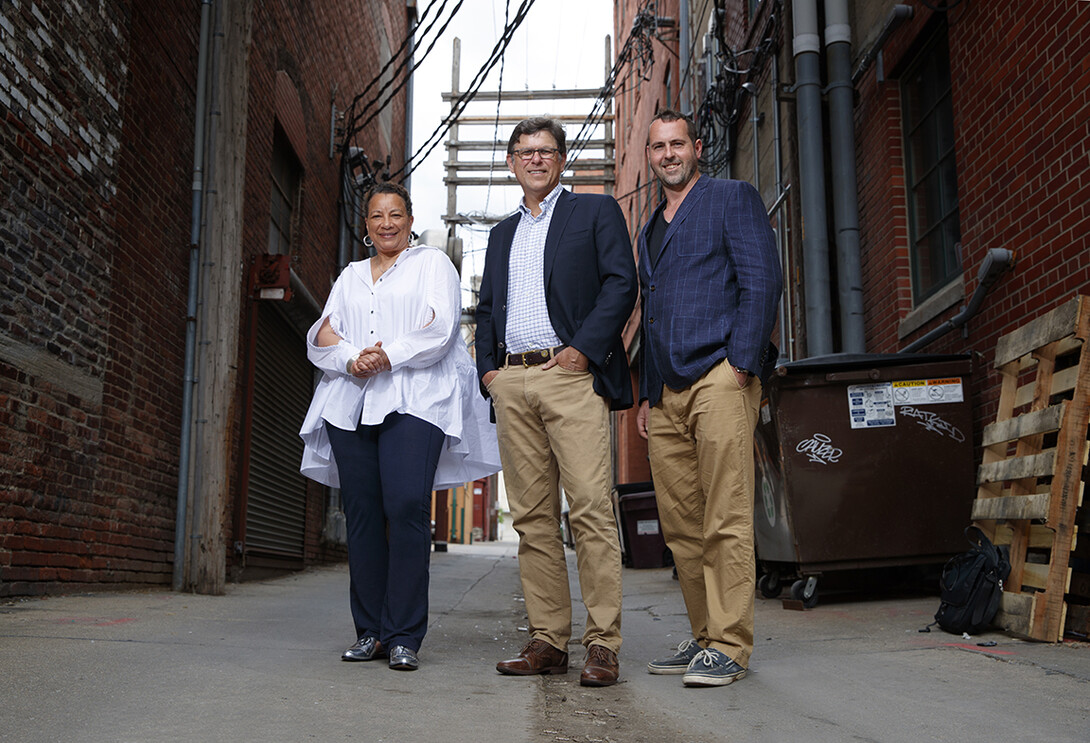
The award-winning University of Nebraska–Lincoln team that produced “Anna” is bringing another important, but lesser-known story to movie screens with its inaugural feature-length animated film, “The Bell Affair.”
“The Bell Affair” tracks the story of the Daniel and Mary Bell family, chronicling the legal fight for Mary’s freedom following a widow’s rejection of a deed of manumission, the legal document granting freedom to an enslaved person signed by a slaveowner. These courtroom battles culminated in an escape attempt on April 15, 1848, when 77 enslaved people boarded the schooner, Pearl. It was the largest escape attempt ever recorded, though unsuccessful.
The new film was produced by Salt Marsh Productions, which was founded by Husker scholars Michael Burton, assistant professor in textiles, merchandising and fashion design; Kwakuitl Dreher, associate professor in English; and William Thomas, professor of history, Angle Chair in the Humanities, and associate dean for research and graduate education in the College of Arts and Sciences. It was produced with funding from prominent humanities organizations, including the National Endowment for the Humanities, Maryland Humanities, and the Kitty M. Perkins Foundation.
Resiliency and family
The film encompasses family and freedom-making, Dreher said, but it is a freedom-making story that differs from what audiences have seen on the screen previously.
“Much of what we know about freedom-making has to do with running away to freedom — the Underground Railroad, getting them and taking them across the land to freedom,” Dreher, the film’s writer and director, said. “Little known history is how enslaved people went to court, and challenged their slavery in court. They had white lawyers, such as Francis Scott Key, who defended them.
“I asked myself the question, if you are planning on making your freedom, what would that look like? And you’re planning on freedom-making for your family? What would that look like? What would the conversations be, because you just don’t wake up and say, ‘Let’s pack our clothes and go to the dock.’”
Dreher thought a lot about the family dynamics at play — multiple generations, both enslaved and free, living in one house — while writing the screenplay, and about her own upbringing in South Carolina.
“It was the first state to secede from the Union in favor of slavery,” she said. “That is where I grew up and they are unapologetic about who they are. It was revelatory for me to write this. I did not know about the Pearl until I read this history. It was so close to home, but it just opened my eyes to the ways in which African-Americans were so resilient.
“It was revelatory for me to be with that history, writing about it, and imagining how they would talk to each other in their living rooms and at their dinner table. It was comforting to be in that space.”

Dreher’s screenplay is based on research done by Thomas’ team through the digital humanities project, “O Say Can You See: Early Washington D.C., Law and Family,” which has chronicled the many freedom suits filed in Washington, D.C., prior to the Civil War. The Bell family’s story was also featured in Thomas’ book, “A Question of Freedom: The Families Who Challenged Slavery from the Nation’s Founding to the Civil War.”
“We encountered all of the Bell family freedom suits in the course of that research,” said Thomas, who wrote the courtroom scenes and served as executive producer. “We did more research on the family because it is such a remarkable story. There were seven major freedom suits brought by this family over 15 years, and one of them went to the Supreme Court, which isn’t shown in the film.
“This family also filed suits for multiple generations. The last freedom suit the Bells filed was for their child, who was 8 years old.”
The Bells’ story will feel new to many viewers of the film, but petitions for freedom in the courts weren’t unusual, Thomas said, and the filmmakers hope the film will inform audiences of these overlooked stories in American history.
“Freedom suits often went through several generations,” he said. “They were part of long-term efforts by these families to stay together and secure their freedom. The Bells, like many others, faced the same dangers and threats and the same difficulties in the courts. But, what the Bells did that no other families did was launch the largest escape attempt in American history.”
An unusual production
Following the success of “Anna,” the filmmakers launched work on “The Bell Affair” in 2019. Just as Dreher and Thomas were finalizing the initial screenplay and Burton was lining up filming at a green screen studio at Nebraska Public Media, the COVID-19 pandemic upended everything.
Burton, executive and supervising producer, immediately began working out a new, entirely remote shooting schedule with the film’s production crew at Western Meadowlark, which was founded by Ben Hartzell and Elijah Watson, alumni of the Johnny Carson Center for Emerging Media Arts at Nebraska.
“I realized that we weren’t going to be able to get 40 actors, plus crew, into the studio over two weeks at the beginning of the pandemic,” Burton said. “We produced this much differently than we anticipated or planned.
“We used an inline editing and animating process, where we were getting footage on a rolling basis, rather than getting it all together and then editing and animating it in post-production.”

Burton said the costume designer, Heather Striebel, did virtual fittings and shipped costumes to the actors. Over Zoom, Dreher had table reads with every actor and gave scene direction while filming.
“Sometimes, I played the different characters, so they could play off of me,” Dreher said. “I think we had a rich tapestry of interpretation of the characters.”
Hartzell lined up the proper shots, which actors filmed themselves.
“The actors were sent a sheet with every single camera angle, and it was all numbered, and Ben put those together so the cast would know which positions the camera needed to be in,” Burton said. “He knew what kind of camera — or phone — each actor had. We sent them tripods, and gave them information and illustrations of how the camera should be positioned.
“It was phenomenal how it came together. When we were assembling it, we didn’t have to change a lot with the animation. The actors were imagining hugging each other, and they’d never met each other, but they knew where each other would be, almost intuitively. They were 1,500 miles apart.”
The film uses the rotoscoping animation technique that was utilized for “Anna.” While “Anna” was rotoscoped by hand, animation head Jordan Scribner, a Husker alum, found new software that aided in the process and drastically cut down the time needed for laying over the animation on “The Bell Affair.”
Despite the pandemic, and the seismic shift it caused, “The Bell Affair” was finished in time for the team to begin submitting it to 2022 film festivals. They also held a preview screening for friends, family and supporters of the project Feb. 23 at the Mary Riepma Ross Center for Media Arts, where the film received a standing ovation. Plans to bring it to Lincoln again are underway.
“The Bell Affair” will have its official premier in Washington, D.C., on June 2, where the Bells’ battle for freedom began.
“The Pearl escape happened there and is a highly significant story in American history, and the Bell family organized this escape,” Thomas said. “They had 11 on the ship, and in Washington D.C. today, it is widely taught in schools, and they still have a commemoration for the Pearl in April. This film speaks to that history.”







